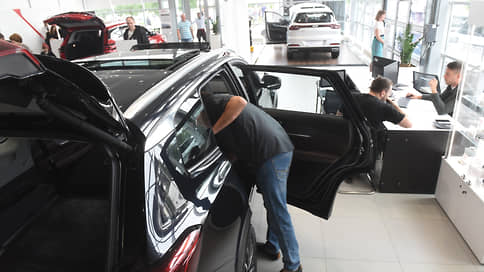In March, Russians emotionally bought cars, fearing their rise in price
[ad_1]

By the end of March, the excitement in the car market approached the level of the first days of hostilities in 2022 – dealers and analysts talk about an increase in “emotional purchases” of cars. Buyers were afraid of an increase in car prices from April 1 due to changes in import rules from the EAEU countries, potential volatility of the exchange rate after the presidential elections in the Russian Federation, as well as the cancellation of discount programs. In such conditions, cars were actively purchased even on credit at 20% per annum. The market expects sales growth to continue in April, as manufacturers need to clear overcrowded warehouses, and buyers are “accustomed to fear of rising prices.”
Sales of new passenger cars in the Russian Federation in the last week of March amounted to 38.4 thousand and almost reached the sales record since the beginning of the crisis, observed from February 28 to March 6, 2022. This data is provided by Autostat. At the beginning of March 2022, citizens bought cars in panic amid announcements about the suspension of supplies from Western automakers.
Now, Kommersant’s interlocutors believe, we are also talking about “emotional purchases.” The main incentive was the expectation that the price of cars would rise from April 1 against the backdrop of changes in import rules from the EAEU countries. Continued discounts and support programs help sales, say dealers and analysts interviewed by Kommersant. “Everyone ran to buy here and now, fearing that it would be more expensive in April and May,” explains Nikolai Ivanov, director of the Rolf new car sales department. Sergei Udalov from Avtostat believes that this is a “distorted understanding of the situation”: although models imported through parallel imports will indeed become more expensive, the global price level is influenced by the volume of warehouses and purchasing power.
General Director of Avtodom Andrei Olkhovsky adds that “one cannot ignore the situation with election procedures in the Russian Federation,” which also affected demand: “There were many reports about a possible increase in the exchange rate after the elections, which could lead to an increase in the cost of cars.”
Demand is also supported by the maximum number of special promotions, subsidized loans and support programs from manufacturers, notes Renat Tyukteev, Avilon’s deputy general director for sales of new cars. Discounts and support programs, as Kommersant wrote on March 14, were launched to sell off stocks in warehouses that were imported into the Russian Federation back in 2023, but were never implemented amid a market slowdown in the fall. Sergei Udalov clarifies that the rate of wastewater accumulation has decreased, but it has not been possible to reduce it.
As a result, in March, sales reached a record level since the beginning of the crisis of 146.5 thousand cars, estimated by Autostat based on data from JSC PPK (a joint venture agency and Electronic Passport).
Dealers expect that sales will at least not decline in April. “The market will be similar to March, since there are still cars at old prices and those who did not have time to buy a car in March will come in April,” says Nikolai Ivanov. He adds that there are no changes to the discount policy for April.
Evgeniy Zhitnukhin, head of the dealership department of the Fresh automobile marketplace, confirms that discounts are maintained, since there are still cars produced in 2023 in warehouses: “They need to be sold out in order to be filled with a new assortment of cars produced in 2024.” He also talks about an increase in salon traffic in April.
“Today, discounts and special offers are still valid for many brands for new cars,” agrees Renat Tyukteev. “By the end of the second quarter, the level of support from manufacturers that stimulates demand will decrease.” Sales growth will continue in April, he adds, “perhaps at a calmer pace than in March.”
“April and May will be a continuation of March,” Andrei Olkhovsky also believes. He emphasizes that “an incredibly large number of cars with preferential customs duties were imported into the Russian Federation, they need to be sold.” “Some sellers will strive to gain additional profit. But I think that this is unlikely to succeed, because there are too many cars,” he says. In the second quarter, sales will increase by 15–20%, but in the following months “the potential will decline if the Central Bank does not lower the key rate,” says Mr. Olkhovsky.
The policy of discounts and special offers also has an effect on buyers, says Sergei Udalov: “Support programs and discounts, unlike changes in recommended retail prices, are canceled one day, and everyone understands this.” Moreover, the analyst does not yet see the risk that current sales will outstrip demand from future periods. Like the dealers interviewed by Kommersant, he points to the factor of pent-up demand.
But prices will rise, market participants emphasize. “The impact of the ban on the import of foreign cars from the EAEU countries on prices is a matter of mathematics,” explains Andrey Olkhovsky. “I think that the growth will be gradual and, in a normalized state, will give an impetus to increasing the cost of cars by an average of 20–25%.”
Sergei Udalov adds that potential buyers are accustomed to existing in a paradigm of constant fear of rising prices for cars, including due to potential changes in the exchange rate. “If possible, they buy a car here and now,” he explains. “For example, car loans are issued not only according to models with subsidized rates, but loans are also actively issued at 20%.”
[ad_2]
Source link





